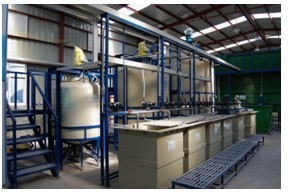- Water reuse system
- Water reuse system
- You are here:Home > Program > Water reuse system > Industrial waste solution
- Industrial waste solution
-
 【Overview】
【Overview】Industrial waste water is generated in the process of industrial production waste water, sewage and waste, which contains water with the loss of industrial production materials, intermediates and products and the pollutants generated in the production process. With the rapid development of industry, type and quantity of wastewater rapid increase in the pollution of water bodies are becoming increasingly widespread and serious threat to human health and safety.
【Waste Classification】Industrial waste water usually has the following three categories:
The first is contained in industrial wastewater according to the chemical nature of major pollutants,including inorganic pollutants based inorganic wastewater containing organic pollutants based organic wastewater。For example,the process of electroplating wastewater and mineral processing waste water,inorganic waste water; food or oil processing wastewater、organic waste。
The second is the company's products by industry classification and processing of objects, such as metallurgical waste water, wastewater, waste gas coking coal, metal pickling waste water,waste water of chemical fertilizer, textile printing and dyeing wastewater, wastewater, wastewater, wastewater, power plants Wastewater。
The third is by water contained in the classification of the major components of pollutants such as acid waste, alkaline wastewater, wastewater containing cyanide, chromium waste water, waste water containing cadmium, mercury-containing waste water, wastewater、and aldehyde wastewater、oily wastewater、sulfur-containing waste water,waste water containing organic phosphorus and radioactive wastewater。
The first two classifications do not involve the major pollutants contained in wastewater composition。 wastewater can not be that harmful。 A third classification、clear that the composition of major pollutants in wastewater can be certain that the danger of waste water。In addition, the main pollutants in wastewater divided into three categories: first category is the waste heat, mainly from the cooling water, cooling water for reuse; second category of conventional pollutants, there is no obvious and easy biodegradable toxic substances, Including the biodegradable organic matter,nutrients can be used as biological compounds, and suspended solids, etc;third category of toxic pollutants, namely, toxic and not readily biodegradable substances, including heavy metals, toxic compounds and not easily biodegradable organic Compounds。
Indeed, an industry can emit several different types of wastewater, and a waste water will have different pollutants and different pollution effects。For example, both the discharge of acidic dye factory wastewater, and discharge of alkaline wastewater。Textile printing and dyeing wastewater, due to the different fabrics and dyes, in which the effects of pollutants and pollution will be very different。Even a wastewater plant, it may also contain several pollutants。If the refinery distillation, cracking, coking, and other devices superimposed oil condensation in the water tower, containing phenol, oil, sulfides。In different industrial enterprises, although the products, raw materials and different processing may also be similar in nature to the wastewater discharge。 Such as refineries, chemical plants and coke gas production, may have oil, phenol wastewater discharge。
- Related Industry
- >> Industrial waste solution
- >> Water reuse solutions





